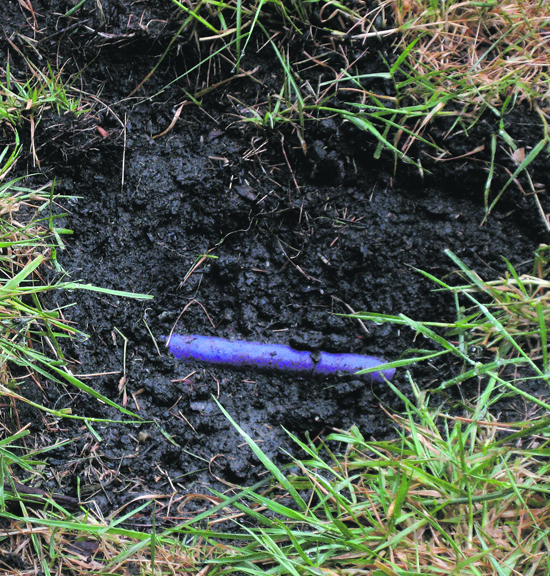 | | | Gwenn Lennox shows the entrance to the gray-water collection tank. Photo Sophie Braccini
| | | | | | When John and Gwenn Lennox decided to rebuild their home in Lafayette, they knew they wanted it to be energy efficient, to incorporate sustainable materials and have a drought resistant landscape -but they never imagined they would end up with home in which they used rain water to wash the laundry and gray-water to keep their lawn green.
 Architect Greg Faulkner came up with the idea; contractor Tom Alderson contacted Brent Bucknum, owner of Hyphae Design Laboratory, who conceived a $30,000 self-sustaining system that's one of a kind in Contra Costa County.
Architect Greg Faulkner came up with the idea; contractor Tom Alderson contacted Brent Bucknum, owner of Hyphae Design Laboratory, who conceived a $30,000 self-sustaining system that's one of a kind in Contra Costa County.
 "The system we set in place is two-fold," explains Gwenn Lennox, sipping tea at her matte red granite counter. "Downspouts collect rain water that drips along the butterfly shaped roof; that water falls in sand boxes that filter it and prevent leaves and other debris from getting into the storage. The rainwater is stored in two 1,700 gallons containers that have been buried under the patio. A pump sends the water back into the house to be used for the laundry, for sinks in the garage and the laundry room, and for our water fountain. The second part is the gray-water recycling."
"The system we set in place is two-fold," explains Gwenn Lennox, sipping tea at her matte red granite counter. "Downspouts collect rain water that drips along the butterfly shaped roof; that water falls in sand boxes that filter it and prevent leaves and other debris from getting into the storage. The rainwater is stored in two 1,700 gallons containers that have been buried under the patio. A pump sends the water back into the house to be used for the laundry, for sinks in the garage and the laundry room, and for our water fountain. The second part is the gray-water recycling."
 Gray-water recycling is the more unusual component of a household system. Use of gray-water has become very common in dry states, especially for golf courses and large expanses of landscape. The same principles are applied here, but on a much smaller scale.
Gray-water recycling is the more unusual component of a household system. Use of gray-water has become very common in dry states, especially for golf courses and large expanses of landscape. The same principles are applied here, but on a much smaller scale.
 The operating mode mimics natural wetlands that purify water by acting like a sponge, and extracting contaminants and nutrients through their extensive root mass. "The system is designed to divert, filter, store and disperse the household gray-water to the drip irrigation system," explains Bucknum, "the Lennoxs' can divert the gray-water to sewer (when they use harsh chemicals for cleaning), or to the in-house treatment system."
The operating mode mimics natural wetlands that purify water by acting like a sponge, and extracting contaminants and nutrients through their extensive root mass. "The system is designed to divert, filter, store and disperse the household gray-water to the drip irrigation system," explains Bucknum, "the Lennoxs' can divert the gray-water to sewer (when they use harsh chemicals for cleaning), or to the in-house treatment system."
 Bucknum created a mini wetland expanse on the side of the house that looks like a pretty, ornamental garden. Gray-water that's water collected from the bathroom showers and sinks, as well as from the laundry room, is reused to water the lawn and many plants (but not the vegetable garden). Designing such a system required building a double plumbing system to separate the collection of recycled and non-recycled waters.
Bucknum created a mini wetland expanse on the side of the house that looks like a pretty, ornamental garden. Gray-water that's water collected from the bathroom showers and sinks, as well as from the laundry room, is reused to water the lawn and many plants (but not the vegetable garden). Designing such a system required building a double plumbing system to separate the collection of recycled and non-recycled waters.
 Although the process is well known internationally and has been in use all over the world, it was a first for the Lafayette Planning Department and Contra Costa Building Inspectors. "The City of Lafayette really helped us in the process," said Lennox, "they were willing to listen and facilitate."
Although the process is well known internationally and has been in use all over the world, it was a first for the Lafayette Planning Department and Contra Costa Building Inspectors. "The City of Lafayette really helped us in the process," said Lennox, "they were willing to listen and facilitate."
 "Water is a resource that we need to conserve and we loved the concept," said Lafayette City Planner Greg Wolf, "the Contra Costa Building Department looked at the intent of the rules and kept the big picture in mind. It was a learning process for us all." The planner hopes to see more of such systems in the future coming for approval in Lafayette, "These are becoming more common practices," said Wolf, "they just are not main-stream, yet."
"Water is a resource that we need to conserve and we loved the concept," said Lafayette City Planner Greg Wolf, "the Contra Costa Building Department looked at the intent of the rules and kept the big picture in mind. It was a learning process for us all." The planner hopes to see more of such systems in the future coming for approval in Lafayette, "These are becoming more common practices," said Wolf, "they just are not main-stream, yet."

|



